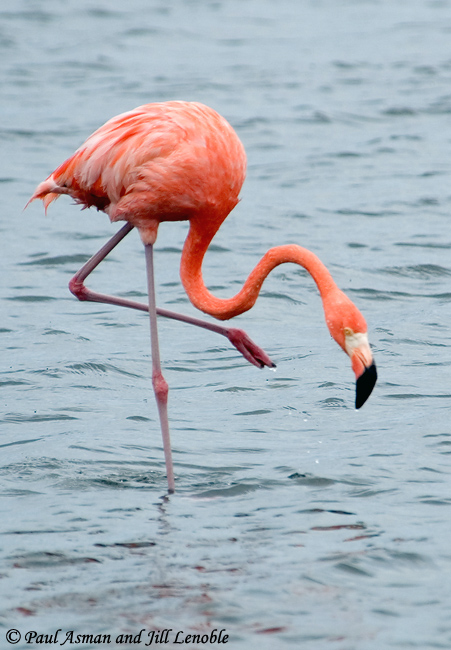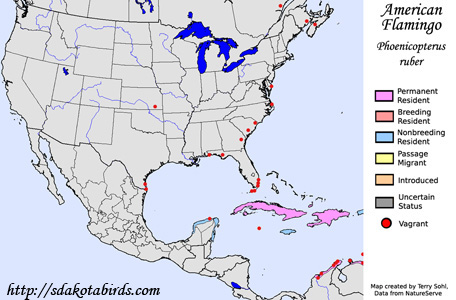| Length: 45 inches | Wingspan: 60 inches | Seasonality: Non-resident in South Dakota |
| ID Keys: Distinctive if seen well, with unique bill, pink plumage overall, black trailing edge on wings in flight. | ||
 The
American Flamingo used to be often called the "Caribbean Flamingo" and was
considered a subspecies of the Greater Flamingo, a species found in the
Eastern Hemisphere, but most groups now consider the American Flamingo to be
a distinct species. The status of the species in the United States is
confounded by the popularity of the American Flamingo as a captive bird, and
many sightings in the U.S. are undoubtedly escapees from captivity.
However, they do nest in Bermuda, parts of the Caribbean, and the Yucatan
peninsula of Mexico, so birds seen in Florida and elsewhere in the
southeastern United States may very well be wild in origin, especially given
a wild population is very close in Cuba. Historically, non-breeding
birds were often found in the Everglades in Florida, so movement of wild
birds to the United States on occasion is likely. Appearance of the
birds typically varies by location, as the pink and red hues in the plumage
are derived from the small crustaceans that they eat. Birds found in
the Caribbean, for example, are typically a much deeper red, while birds in
parts of South America are more of a pale pink.
The
American Flamingo used to be often called the "Caribbean Flamingo" and was
considered a subspecies of the Greater Flamingo, a species found in the
Eastern Hemisphere, but most groups now consider the American Flamingo to be
a distinct species. The status of the species in the United States is
confounded by the popularity of the American Flamingo as a captive bird, and
many sightings in the U.S. are undoubtedly escapees from captivity.
However, they do nest in Bermuda, parts of the Caribbean, and the Yucatan
peninsula of Mexico, so birds seen in Florida and elsewhere in the
southeastern United States may very well be wild in origin, especially given
a wild population is very close in Cuba. Historically, non-breeding
birds were often found in the Everglades in Florida, so movement of wild
birds to the United States on occasion is likely. Appearance of the
birds typically varies by location, as the pink and red hues in the plumage
are derived from the small crustaceans that they eat. Birds found in
the Caribbean, for example, are typically a much deeper red, while birds in
parts of South America are more of a pale pink.
Habitat: Found in brackish, shallow waters and coastal lagoons. They are found inland on select brackish or salty inland water bodies, as well as along the coast.
Diet: Filters out small food items in the water, such as diatoms, algae, aquatic insects and their larvae, and small crustaceans and mollusks.
Behavior: Feeds by sweeping its unique beak side-to-side through the water, taking in water and filtering out small invertebrates by straining the water out through keratinous plate structures within its beak. They are a gregarious species, typically found in groups both during and outside of the breeding season.
Nesting: The American Flamingo nests in dense colonies, with a select number of traditional breeding colonies in the New World. Breeding colonies occur on mudflats, with females constructing individual nests made of cones of mud, sometimes with feathers and plant material as well. Both parents tend to the young upon hatching.
Interactive eBird Map: Click to access an interactive eBird Map of American Flamingo sightings
Song: The American Flamingo has multiple vocalizations, including a goose-like honking sound given in flight, as well as low-pitched babbling while feeding in groups. Courting males and females have additional cackling vocalizations, with higher-pitched notes by females.
Migration: The American Flamingo breeds in a wide variety of locations in the western Hemisphere, including parts of the Caribbean, Bermuda, the Yucatan peninsula of Mexico, the Galapagos Islands, and scattered locations along the coasts of South America.
Similar Species: Distinctive, not likely to be confused with another species in range if seen well. Coloring is vaguely similar to Roseate Spoonbill or Scarlet Ibis, but size, structure, plumage differences, bill shape, and many other features distinguish the American Flamingo from similarly colored birds.
Conservation Status: The American Flamingo has a widespread range and appears to be increasing in population. The IUCN lists the American Flamingo as a species of "Least Concern".
Further Information: 1) WhatBird - American Flamingo
2) Birdlife International - American Flamingo
3) Cornell's Neotropical Birds - American Flamingo
Photo Information: Photo taken by Paul Asman and Jill Lenoble - April 15th, 2010 - Riscado, Netherlands Antilles - Photo licensed under Creative Commons Attribution 2.0 Generic License.
| Click below for a higher-resolution map |
 |
| South Dakota Status: Non-resident in South Dakota |
Additional American Flamingo Photos (coming soon!!)
